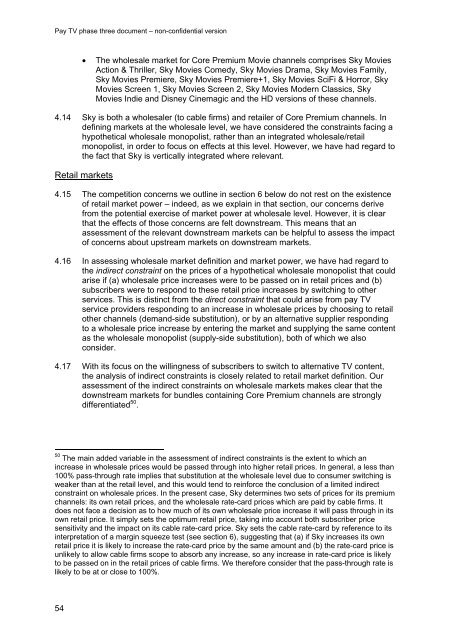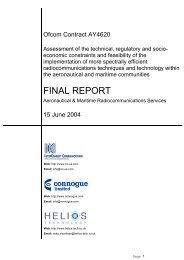Pay TV phase three document - Stakeholders - Ofcom
Pay TV phase three document - Stakeholders - Ofcom
Pay TV phase three document - Stakeholders - Ofcom
Create successful ePaper yourself
Turn your PDF publications into a flip-book with our unique Google optimized e-Paper software.
<strong>Pay</strong> <strong>TV</strong> <strong>phase</strong> <strong>three</strong> <strong>document</strong> – non-confidential version<br />
54<br />
� The wholesale market for Core Premium Movie channels comprises Sky Movies<br />
Action & Thriller, Sky Movies Comedy, Sky Movies Drama, Sky Movies Family,<br />
Sky Movies Premiere, Sky Movies Premiere+1, Sky Movies SciFi & Horror, Sky<br />
Movies Screen 1, Sky Movies Screen 2, Sky Movies Modern Classics, Sky<br />
Movies Indie and Disney Cinemagic and the HD versions of these channels.<br />
4.14 Sky is both a wholesaler (to cable firms) and retailer of Core Premium channels. In<br />
defining markets at the wholesale level, we have considered the constraints facing a<br />
hypothetical wholesale monopolist, rather than an integrated wholesale/retail<br />
monopolist, in order to focus on effects at this level. However, we have had regard to<br />
the fact that Sky is vertically integrated where relevant.<br />
Retail markets<br />
4.15 The competition concerns we outline in section 6 below do not rest on the existence<br />
of retail market power – indeed, as we explain in that section, our concerns derive<br />
from the potential exercise of market power at wholesale level. However, it is clear<br />
that the effects of those concerns are felt downstream. This means that an<br />
assessment of the relevant downstream markets can be helpful to assess the impact<br />
of concerns about upstream markets on downstream markets.<br />
4.16 In assessing wholesale market definition and market power, we have had regard to<br />
the indirect constraint on the prices of a hypothetical wholesale monopolist that could<br />
arise if (a) wholesale price increases were to be passed on in retail prices and (b)<br />
subscribers were to respond to these retail price increases by switching to other<br />
services. This is distinct from the direct constraint that could arise from pay <strong>TV</strong><br />
service providers responding to an increase in wholesale prices by choosing to retail<br />
other channels (demand-side substitution), or by an alternative supplier responding<br />
to a wholesale price increase by entering the market and supplying the same content<br />
as the wholesale monopolist (supply-side substitution), both of which we also<br />
consider.<br />
4.17 With its focus on the willingness of subscribers to switch to alternative <strong>TV</strong> content,<br />
the analysis of indirect constraints is closely related to retail market definition. Our<br />
assessment of the indirect constraints on wholesale markets makes clear that the<br />
downstream markets for bundles containing Core Premium channels are strongly<br />
differentiated 50 .<br />
50 The main added variable in the assessment of indirect constraints is the extent to which an<br />
increase in wholesale prices would be passed through into higher retail prices. In general, a less than<br />
100% pass-through rate implies that substitution at the wholesale level due to consumer switching is<br />
weaker than at the retail level, and this would tend to reinforce the conclusion of a limited indirect<br />
constraint on wholesale prices. In the present case, Sky determines two sets of prices for its premium<br />
channels: its own retail prices, and the wholesale rate-card prices which are paid by cable firms. It<br />
does not face a decision as to how much of its own wholesale price increase it will pass through in its<br />
own retail price. It simply sets the optimum retail price, taking into account both subscriber price<br />
sensitivity and the impact on its cable rate-card price. Sky sets the cable rate-card by reference to its<br />
interpretation of a margin squeeze test (see section 6), suggesting that (a) if Sky increases its own<br />
retail price it is likely to increase the rate-card price by the same amount and (b) the rate-card price is<br />
unlikely to allow cable firms scope to absorb any increase, so any increase in rate-card price is likely<br />
to be passed on in the retail prices of cable firms. We therefore consider that the pass-through rate is<br />
likely to be at or close to 100%.
















